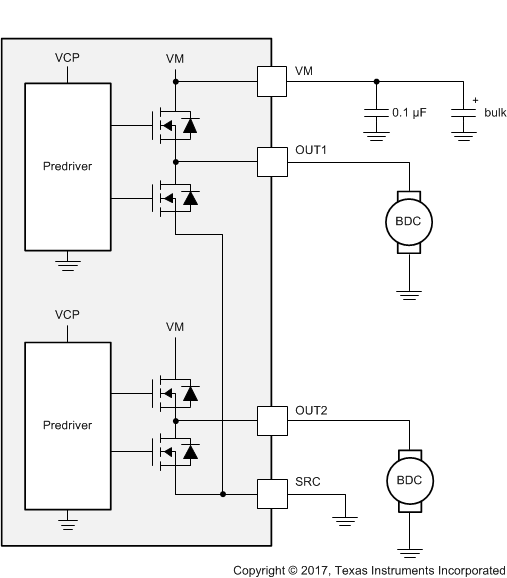SLVSET1 August 2018 DRV8873
PRODUCTION DATA.
- 1 Features
- 2 Applications
- 3 Description
- 4 Revision History
- 5 Pin Configuration and Functions
- 6 Specifications
-
7 Detailed Description
- 7.1 Overview
- 7.2 Functional Block Diagram
- 7.3 Feature Description
- 7.4 Device Functional Modes
- 7.5 Programming
- 7.6 Register Maps
- 8 Application and Implementation
- 9 Power Supply Recommendations
- 10Layout
- 11Device and Documentation Support
- 12Mechanical, Packaging, and Orderable Information
7.3.1.2 Half-Bridge Operation
The device can be used to drive two solenoids or unidirectional brushed DC-motor loads instead of a brushed-DC motor in full H-bridge configuration. Independent half-bridge control is preferred for operation in this mode; however, using the PH/EN or PWM modes is not restricted if the correct driving and braking states can be achieved.
 Figure 11. Independent Half bridge Mode Driving Two Low-Side Loads
Figure 11. Independent Half bridge Mode Driving Two Low-Side Loads TI does not recommend tying the OUT1 and OUT2 pins together and drive a load. The half bridges may be out of synchronization in this configuration and any mismatch in the input commands can momentarily result in shoot through condition. This mismatch can be mitigated by adding an inductor in-line with the outputs.
If loads are connected between the OUTx and VM pins, the device can draw more current than specified in the Electrical Characteristics table. To avoid this condition, TI recommends connecting loads in the configuration shown in Figure 11.
Depending on how the loads are connected on the outputs pin, some of the features offered by the device could have reduced functionality. For example, having a load between the OUTx and GND pins, as shown in Figure 11, results in false trips of the open-load diagnosis in active-mode (OLA). Having a load tied between the OUTx and VM pins restricts the use of internal current regulation because no means of measuring current flowing through the load with the current mirror block is available. Table 7 lists these use cases.
Table 7. Control Mode Configuration
| LOAD CONNECTIONS | FUNCTIONALITY | ||
|---|---|---|---|
| NODE 1 | NODE 2 | OLA | CURRENT REGULATION (ITRIP) |
| OUTx | GND | Not Available | Operational |
| OUTx | VM | Operational | Not Available |